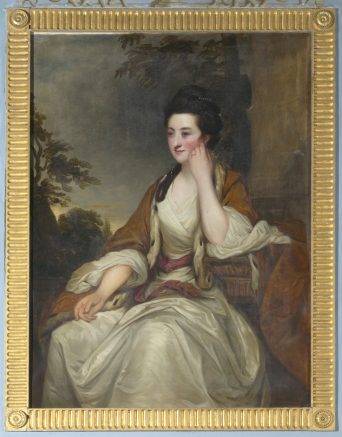Castletown flourished under Thomas Conolly and Lady Louisa.
Lady Louisa, the third of the famous daughters of the Duke of Richmond, had spent much of her childhood at Carton near Maynooth, the home of her sister Emily, Countess of Kildare and later Duchess of Leinster. Her elder sister Caroline married the leading English politician Henry Fox, while her younger sister Sarah led a turbulent private life before eventually settling down in Oakley Park in Celbridge in 1781.
Lady Louisa had no children and instead devoted much of her energies to improvements to the house and demesne at Castletown. The Staircase Hall, Dining Room, Print Room and Long Gallery are amongst the rooms that can be considered symbols of her contribution to the house. Castletown in these years again became a lively, hospitable place with a constant stream of visitors including everybody from the Lord Lieutenant to London actress Sarah Siddons.
Thomas Conolly was the quintessential Irish gentleman, a keen huntsman and a fine horseman, as well as a politician and landowner. Regarded as the wealthiest commoner in the kingdom, he actually spent much of his career in debt because of large debts he inherited from his father. Although a patriot in the broadest sense of the word, Conolly was a strong supporter of the Act of Union in 1800. This support for the Union, which extinguished the independent Irish Parliament in College Green, was partly influenced by the 1798 rebellion which had a profound effect on the extended Conolly/FitzGerald family. At Castletown twelve servants and footmen were dismissed for involvement in the rebellion. At the same time, the Conollys grieved over the death of Lady Louisa’s favourite nephew, the United Irishman leader Lord Edward Fitzgerald. She was amongst the last people to see him before his death in Newgate gaol in May 1798.
Following Thomas’s death in 1803, Lady Louisa changed her lifestyle and devoted the remaining years of her life to charitable works instead of improvements to the house and estate. Amongst her achievements was the establishment of a school inside the gates of Castletown. A new Protestant church was also erected inside the gates to replace the previous church, which had been destroyed in the 1798 rebellion. She survived her husband by eighteen years and died in August 1821.
Lady Louisa’s death in 1821 ended an era at Castletown.
The Conolly estates, including Castletown, were inherited by Thomas Conolly’s grandnephew Edward Pakenham (1786–1848). Under the terms of Conolly’s will, Edward was required to change his name to Conolly. Thomas Conolly had also hoped and recommended that his heirs “will be resident in Ireland as their ancestor, Mr Speaker Conolly, the original and honest maker of my fortune, was.” The estates Edward Conolly inherited were heavily encumbered, and the family’s fortunes declined financially as well as politically. In the eighteenth century Castletown was the main residence of the Conolly family, but after the Act of Union in 1800 Dublin declined as a political and social centre. From 1830, Edward Conolly spent much of his time in London attending parliament and Castletown was used as a country retreat. At Westminster he often spoke on Irish affairs telling the House of Commons in 1847 during the great famine to ‘throw political economy to the wind and listen to the starving people.’ Returning to Castletown, he contributed to the local relief effort and donated land for the Celbridge workhouse. Few changes were made to the house in this period, probably due to the straightened economic circumstances, other than the provision of a nursery and a schoolroom for his ten children.

